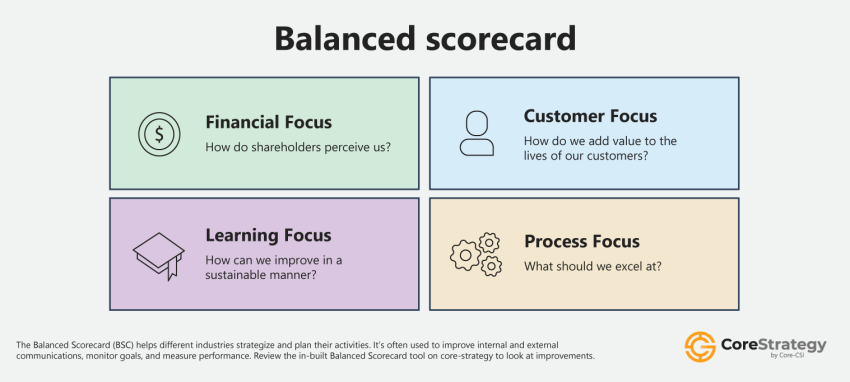Posted on April 20, 2022
In their book The Balanced Scorecard, authors David Norton and Robert Kaplan note that 90% of organizations fail to execute their business strategies successfully. Most organizations start with pre-conceived notions of failure and label strategy development and execution practices as leadership requirements or just academic exercises. Once there is a recognition that strategic management is essential for lasting success, the organization develops or updates mission and vision statements to establish goals and objectives, but that is just the beginning.

Most of the demanding work lies below the surface to understand established cultural norms and issues. Leadership and management must demonstrate firm commitment toward change and promote organizational buy-in. They must confirm workforce realization of the need for change and understand current and desired organizational capabilities.
Organizations must track objectives and key results, conduct periodic reviews of strategic initiatives milestones, establish accountability reporting, and persistently track progress. As required, perform the course correction when deviations are detected impacting the strategic priorities. The following paragraphs list the top five (5) reasons strategies fail to deliver expected results.
Failure to have a consistent, singular business strategy
While every industry is different when developing an organizational strategy, the organizational change tempo can be determined by the industry norms and the change acceptance from its culture. The hyper-competitive private sector companies may pivot more frequently than their government counterparts.
A mature strategic plan and its execution lead to success in every aspect of the organization-wide activities; on the contrary, frequent changes to its strategic direction promote confusion and frustration among the workforce and highlight the inability to make progress in any single direction. Similarly, an organization catering to multiple strategic plans makes alignment impossible, leading to failed execution and contribution toward organization-wide uncertainty.
Too many unrealistic goals and objectives.
At the onset of establishing strategy or a change in senior leadership, there may be a heightened motivation to change the direction. It often starts with a quick review of the as-is state, establishing aggressive and sometimes lofty goals and objectives. If the new direction sets too many new/changed goals and objectives, the leadership team’s inability to identify and eliminate non-critical initiatives. The new goals and objectives may stretch the organization’s resources, but they must still be realistic to achieve in the accepted timeframe. If the workforce feels that the goals are unachievable, they may not participate or superficially support the new direction.
Incompetent Leadership
Regardless of the industry, many strategies fail due to a lack of leadership toward the organization’s success. Establishing a performance-based organization needs more than just managers; it needs leaders. Exemplary leaders believe in their vision, and their ability to execute the new strategic direction is evident in their day-to-day conduct. They lead by example and hold themselves responsible for any deviations; they demand accountability from the rest of the organization.
Failure to Execute
Depending upon the organization’s culture and change acceptance, there can be many reasons why strategy execution fails. Following are a few common themes:
- Unrealistic expectations and timelines at different levels of the organization (leadership management and the workforce).
- Lack of understanding or unrealistic understanding of the organization’s resource capabilities (people, processes, technology, and funding).
- Organization’s inability to align projects and individual workstreams to the highest level of organizations drivers.
- Lack of accountability; if managers and the workforce do not understand their respective roles in the strategy execution and reporting (automated with strategy management tools), it will be business as usual for a few frustrated individuals.
- Lack of transparency toward achieving strategic goals and objectives leads to falsification or incomplete progress reporting, preventing leaders from obtaining an accurate picture and gauging the impacts of strategy implementation.
- Organization management and workforce inability to differentiate between tactical planning/ execution vs. strategic management; unless there is an organization-wide focus on strategy implementation, managers and the workforce typically default to business as usual.
Strategic Communication
Active communication builds trust and understanding; it motivates the workforce to realize that their actions directly impact their customers and stakeholders. Lack of communication planning and leadership conducting the periodic evaluation of its communication effectiveness leads to a workforce not understanding their role or how their day-to-day actions help the organization achieve its strategic goal and objectives.
Conclusion
Often leaders and managers see strategy only as an intellectual exercise. They put 80% of their effort into logic, costs, and features. They should put 80% of their effort into emotions, feelings, trust, and security. The 18 Inches from the head to the heart is a long journey. Until this unconscious level is addressed, nothing changes. It is like an iceberg; we address the most visible bit, forgetting that so much lies unseen below the waterline (Holland).
Core-Strategy
Core-Strategy is an enterprise-grade strategy management tool for modern enterprises. It helps organizations formulate, plan, implement and evaluate the progress of drivers, goals and objectives. Providing evidence-based decision management capability to senior leadership. Sign up for a no-obligation trial today
About Core-CSI
Core-Cyber Security Integrators (Core-CSI) provides trusted, results-oriented, and proven Program/ Project Management, Enterprise Architecture, System Engineering, Business Process Re-engineering, and Cyber Security support services to the US Intelligence Community, Department of Defense, Federal, and Commercial customers across the US.
Proprietary Information© 2022 Core-CSI LLC All Rights Reserved
